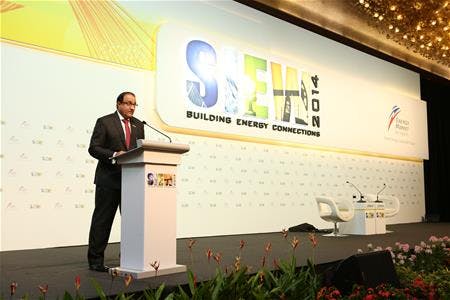Singapore is setting up a new $25 million fund to support the development of energy storage and related technologies which will strengthen the stability and resilience of its power grid.
Minister in the Prime Minister’s Office, S Iswaran, announced this at the opening of the annual Singapore International Energy Week on Monday.
Noting that energy storage is an “emerging area that has the potential to help manage solar intermittency”, he said the new Energy Storage Programme by the Energy Market Authority (EMA) will support the development and integration of large-scale systems that will meet local needs as well as generate opportunities through exportable solutions.
Addressing a 1000-strong industry audience, Iswaran noted that two key developments have resulted in significant shifts in the energy sector.
The first is the extracting of unconventional gas and oil, which has “profoundly reshaped the future of our global energy mix”.
The other big story, he said, is the rise of renewable energy.
According to the 2014 BP Statistical Review of World Energy, renewables now account for more than 5 per cent of global power output and continues to grow robustly.
Solar photovoltaic installations grew by 38.4 gigawatts (GW) last year – a jump from previous years where it hovered around 30 GW.
In Singapore, the government is focused on scaling up the use of solar energy – the country’s most viable renewable energy option – to 350 MW by 2020, up from 20 MW last year under its SolarNova programme, which aims to accelerate the uptake of solar technology in Singapore by having public agencies procure PV installations across government buildings and spaces.
The first aggregated tender will be launched early next year, said Iswaran, who is also Second Minister for Home Affairs and Trade and Industry.
The EMA and Singapore Power (SP) have also shortened the grid connection process for solar PV installations from 27 to seven working days and eased administrative requirements imposed on solar PV owners, he added.

S Iswaran, Minister in the Prime Minister’s Office, speaking at the 2014 Singapore International Energy Week. Image: siew.sg
Other initiatives announced at the event, held at the Marina Bay Sands Expo and Convention Centre, included a $20 million fund to train local professionals for the power sector.
Singapore Power will also be setting up the Singapore Institute of Power and Gas to provide training courses for Singapore’s power and gas sector.
SP managing director Christopher Lim told Eco-Business that while the initial focus would be to provide training for the conventional oil and gas sector, the new centre will also be exploring courses for emerging sectors.
“Renewables is an area that we are looking ito, and we will roll that out when we’re ready next year,” he said.
From July, more businesses will also be eligible to buy electricity from retailers of their choice.
Currently, only commercial and industrial consumers with an average monthly electricity consumption of at least 4,000 kWh (kilowatt hours) can do so. This will be lowered to 2,000 kWh and about 10,000 consumers will be able to benefit from this, adding to the current 23,000 eligible consumers.
Speakers at the Singapore Energy Summit also discussed Asia’s energy connections and the Asean Power Grid, a programme mandated in 1997 by Asean governments to implement a region-wide energy grid.
Such a grid would integrate Asean’s energy markets, and would require investments into trans-Asean gas pipelines and expanding connections between member countries.
Asian Development Bank senior advisor and practice lead (energy) Anthony Jude noted that there are many existing gas pipelines in Asean that are underutilized and should be opened to third parties.
“But government regulations need to be in place (for this) and this is what is missing in Asean,” he said.
He also noted that there is an Asean policy of raising the proportion of renewable energy used in the region to 15 per cent by 2015. But while there are government mandates to produce energy from renewables, there are no mandates for utilities to buy this energy. This is a gap that needs to be addressed, he said.
Separately, Iswaran commented that there is much potential for Asean countries to explore multilateral interconnections.
The pilot study by Lao PDR, Thailand, Malaysia and Singapore, announced earlier in September, is one example which will assess the technical viability of cross border power trade of up to 100 MW from Lao PDR to Singapore through existing inter-connections, as well as the policy, regulatory, legal and commercial issues which could affect cross border electricity movement.
This will complement existing efforts towards realising the Asean Power Grid, he added.

















